Treasures from a forgotten retreat offer insight into the opulent life of a Chinese monarch
Beijing’s sprawling Forbidden City—the size of 135 football fields—is a dizzying array of magnificent receiving halls and intimate quarters surrounded by 28-foot-thick walls. Labyrinthine stone pathways connect its nearly 600-year-old core structures that look as though they were dipped in the same bottomless can of glossy red paint. Accented with intricate geometric, animal, and floral motifs that dazzle in brilliant blues, greens, and golds, the imperial complex is topped with gently sloping roofs comprised of zillions of yellow terracotta tiles. Yet in the northeast tip of the compound lies a unique two-acre retreat, known simply as the “Qianlong Garden” after the emperor who designed and commissioned it between 1771 and 1776. Ninety of the ruler’s prized possessions from this area, ranging from gilded cabinets and jade-encrusted thrones to European-style clocks and fine calligraphic inscriptions, are on view in “The Emperor’s Private Paradise: Treasures from the Forbidden City” at the Metropolitan Museum of Art.
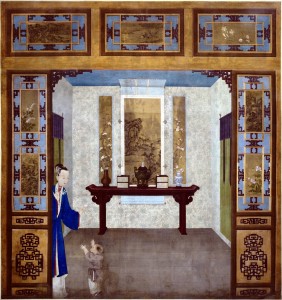
Interior scene; ink and colors on silk (Photo courtesy of the Palace Museum)
The Qianlong Emperor spared no expense on construction materials for this palatial gem, whose 27 rooms were crafted of fine hardwoods lavishly inlaid with jade and porcelain. Inside, they brimmed with fantastic murals, priceless furnishings, and exotic decorative arts. Qianlong had promised to retire there when his reign hit its 60th year in 1795—so as not to overtake the record set by his grandfather—and technically, he abdicated the throne. However, he continued to rule behind the scenes for four more years until his death in 1799. “He never even occupied the retirement palace,” says Maxwell K. Hearn, Curator in Charge of the Metropolitan’s Department of Asian Art. “He never moved out of the other apartments in which he was living in the Forbidden City. I bet you he actually built this as a place for his mother who celebrated her 85th birthday there in 1776.”
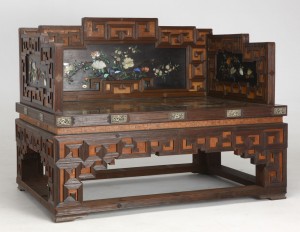
Throne; zitan, bamboo, jade, semiprecious stones, and lacquer (Photo courtesy of the Palace Museum)
The most unusual aspect of this intriguing garden complex is its unparalleled state of preservation. Qianlong decreed as an imperial edict that the lodge would always be reserved for the retiring emperor. As it turns out, he was the only one. So its interiors were never drastically altered, as were many parts of the Forbidden City to create rooms for new concubines, princes, and workshops; and eventually, the area was closed off and the garden became overgrown. “Ironically, the neglect preserved it,” says Hearn. Indeed, the works on view in the Met’s show—such as a throne made of purple sandalwood and bamboo, inlaid with jade and semiprecious stones—glisten as though they just left a craftsman’s rough hands. “I think the garden is probably the only space in the Forbidden City that has been preserved like a time capsule,” Hearn adds. “That’s what makes it so exciting for me. We really have a suite of objects that was there in the 18th century—the architecture, the furnishings, the decorative materials—and it reflects the actual taste of the Qianlong Emperor right at the moment when his reign was at its peak.”
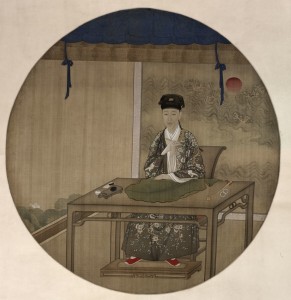
Informal portrait of the Qianlong Emperor in ancient costume; ink and colors on silk (Photo courtesy of the Palace Museum)
Many works in the exhibition fuse Eastern and Western artistic traditions. In an “informal” portrait on view in the first gallery, for example, the emperor is depicted as a scholar composing a poem on a banana leaf. Interestingly, he is shown in a cap and flowing embroidered robe with wide sleeves typical of the previous Ming Dynasty—perhaps a calculated effort to appear like a native Chinese literatus rather than a Manchu. “Qianlong was clearly fascinated with the power of art to create illusions,” says Hearn. “But also, the flip side of that is the power of art to create a sense of reality when maybe that reality was not what it seemed.” Japanese lacquered cabinetry and European clocks in the show help illustrate this point. “One reason he was interested in collecting these exotic things was the Buddhist belief that he was a manifestation of Manjushri, the Bodhisattva of Wisdom, and ultimately the chakravartin, the term for ‘universal ruler,’ ” Hearn explains. “In thinking of himself in that role he saw all of the tribute, all of the trade items that came to China from abroad, as acknowledgments of his sovereignty over all these cultures. He really deluded himself in a way—ultimately, he saw in the mirror of art what he wanted to see.”
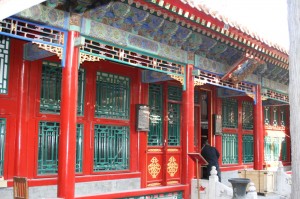
Juanqinzhai, the Studio of Exhaustion from Diligent Service (Photo by Eti Bonn-Muller)
I witnessed the emperor’s love for illusion firsthand when I was invited to visit a section of the Qianlong Garden in November 2007 before it opened to the public. Unlike the rest of the Forbidden City, much of the garden’s exterior beauty rested in its natural surfaces that had dulled with age. Dust rose and settled on the floor in a puddle of sunlight as I stepped into Juanqinzhai, or the Studio of Exhaustion from Diligent Service, where the exterior had been restored to its former glory but work on the interior was underway. I felt like the emperor himself inspecting the progress of the construction, especially when I was allowed to view the room from his throne area. It is the optimal vantage point from which to enjoy the trompe l’oeil effect of the silk-backed panels that line the walls and ceiling of the room, which was used as his personal theater. From just the right angle, plump wisteria drip from vines above and cranes graze amid bamboo stalks beyond doors where actors entered the stage. (Juanqinzhai opened to the public in 2008. Restoration of the entire Qianlong Garden will be completed in 2019.)
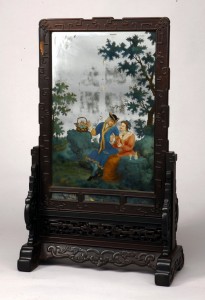
Table screen; zitan, glass, silver foil, and paint (Photo courtesy of the Palace Museum)
The extravagance of the Qianlong Emperor was so great that he ultimately bankrupted the country. “It was the beginning of the end,” says Hearn. “Like the yin and yang cycle of life; when one attains the maximum yang, there is only one direction to go.” In subsequent years came the Opium Wars, the Boxer Rebellion, occupation of various places by European powers, and finally, the Sino-Japanese War and World War II. “It was the beginning of a long wave of chaos,” he says. But, as the exhibition demonstrates, “China truly was the wealthiest empire in the world in the 18th century. I’m sure that if you aggregated the wealth of China, it would outshine any European monarch, maybe even all of the European monarchs rolled into one. I think that’s something people have never really appreciated.”
“The Emperor’s Private Paradise: Treasures from the Forbidden City” is on view at the Metropolitan Museum of Art through May 1. It was previously on view at the Peabody Essex Museum and will travel next to the Milwaukee Art Museum.



